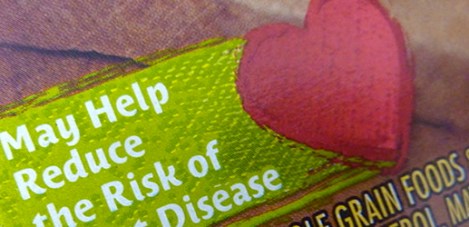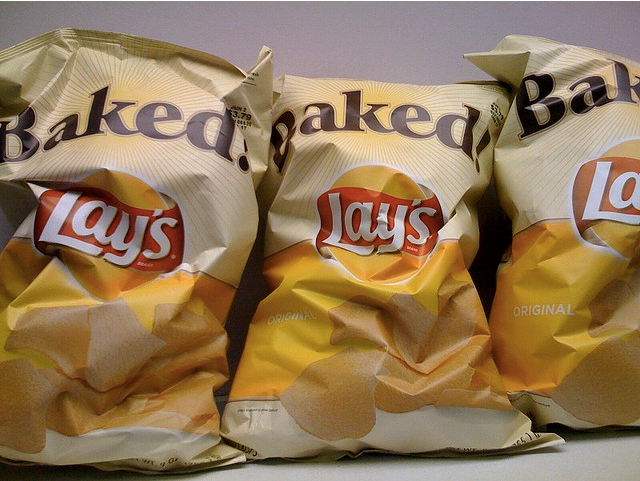
Like real celebrities, real food doesn’t need to shout about its health benefits. Processed foods, on the other hand, need all the help they can get.
Fat free! Now with whole grains! Only 100 calories! Zero grams trans fat! All-natural!
Fake health foods are the carnival barkers of the grocery store, shouting at you from every aisle, promising longevity, beauty, and true happiness, if only you’ll buy them. Fake health food is a wolf in sheep’s clothing, a vicar in a tutu. Here are some of the worst examples:
Vitamin-enriched water is often filled with sugar. Most of them also make big health claims (mood enhancing, energizing, more brain power, etc.) with no evidence to back them up.
Vegetable chips are just chips. They are deep-fried, and contain plenty of fat, salt, and empty calories, just like any other chip.
Granola is super-awesome hippie health food, right? Not usually. Most granolas are loaded with sugar and fat. Make your own!
Flavored yogurt contains fruit, right? Yes, but it’s usually highly processed fruit. Also: sugar, sugar, and more sugar.
Granola bars and energy bars are almost always weighed down with calories, and lots of them contain high fructose corn syrup, palm oil, or other not-so-healthy oils.
Baked chips might contain less fat, but they’re about as good for you as eating salty cardboard. Actually, cardboard would have more fiber.
Almost every item in these “healthy” vending machines also qualifies as fake health food.
So, how can I tell the difference?
Start by steering away from any food with a health claim on the front of the package. In the same way that really famous people don’t have to walk around telling everyone how famous they are, truly healthy food doesn’t go around shouting about it. Have you ever seen a bunch of kale with a “low fat” sticker? Here are my translations of some of the most common health claims:
Enriched: The original nutrients were all processed out so the manufacturers had to put a few back in. I recommend eating the whole food, not a (processed) enriched version.
Better for you: Than what? Cyanide? Sulfuric acid? A kick in the pants? Guess what, it’s also worse for you. Than what? Real food.
Fat-free: Fat is not the enemy and fat-free doesn’t mean it won’t make you fat. It probably contains sodium, sugars, and additives to make up for the flavor lost by excluding fat.
Made with whole grains, real fruit, etc.: This usually means that the manufacturer added a little of the healthy ingredient so they could say “made with” on the package. Instead of eating something that is “made with” whole grains or real fruit, just eat whole grains or real fruit.
Only 100 calories: That’s exactly 100 more empty calories than you need.
Zero grams trans fat: By FDA rules, food can have 0.5 g trans fat per serving and still be labeled “0 grams trans fat.” Aside from being stupid, this rule means you still get plenty of trans fat if you eat the whole box.
All-natural: This means it was made on Earth, from things found on Earth, not excluding any kind of chemical, genetically engineered (GMO) ingredient, or synthetic compound. In fact, it could probably be made on Mars, since the FDA doesn’t define “all-natural” and doesn’t restrict its use. (Note: With meat and poultry, the “natural” label does have an official USDA definition.)
Helps Maintain ___ or May Help ___ : Manufacturers are free to say absolutely anything after vague phrases like this. Note to self: manufacture candy bar that “helps maintain a Kim Kardashian body and a mind like Einstein.”
Is it bad for the environment?
Many fake health foods are manufactured (there’s that word again) with GMO corn and soy products. That means they’re the product of industrial-scale farming, which utilizes mass quantities of pesticides, not to mention synthetic nitrogen fertilizers that end up in waterways and feed the Gulf Dead Zone.
Palm oil is another red-flag ingredient that’s found all over the fake health food market. The advent of municipal trans-fat bans caused lots of manufacturers to replace heavy, hydrogenated oils with palm oil. Now they can say “0 grams trans fat” on the box, but that doesn’t allow them any such claim when it comes to rainforests.
Much of the world’s palm oil is grown in Malaysia and Indonesia. Palm oil producers slash and burn old-growth rainforests and plant huge monocrops of palm fruit trees. This is not only deadly to species such as orangutans, but it takes away the food and habitat of people that have been living in these forests for centuries. They are often left with no option but to work on the plantations, sustaining a grueling life for a barely living wage. Even if you don’t care about orangutans or indigenous peoples, remember, rainforests are the lungs of this planet. Without them, fewer greenhouse gases are absorbed, and the amount of carbon in the atmosphere continues to rise.
Though it may be healthier than trans fat, recent science suggests that palm oil might not be very good for you either.
What should I eat instead?
If you really want a naughty snack, I say go for the gusto and eat real junk food. Chances are you’ll eat a lot less, because you won’t be able to fool yourself into thinking it’s healthy. I would choose real potato chips (potatoes, vegetable oil, sea salt) over a bag of faux-healthy Baked Cheetos (which have more than 20 ingredients, including our mysterious friends Artificial Flavor and Artificial Color) every single time.
It’s pretty simple to make the move from fake health food to real food. Instead of snack crackers and vegetable chips, make your own popcorn or eat dry roasted nuts. You’ll get the salty, fatty snack you’re craving without the processed empty calories.
Instead of granola bars and energy bars, I throw together my own trail mix with nuts, dried fruit (preferably not cranberries, as they often have added sugar), and even high-quality chocolate chips. This is so much more satisfying.
And instead of vitamin-enriched water, just drink water. Seriously. If you’re reading this blog, chances are you have the best drink available straight from your tap. (Some of you might not, and for that I am truly sorry. But doesn’t it piss you off that those of us who do don’t appreciate it?)



